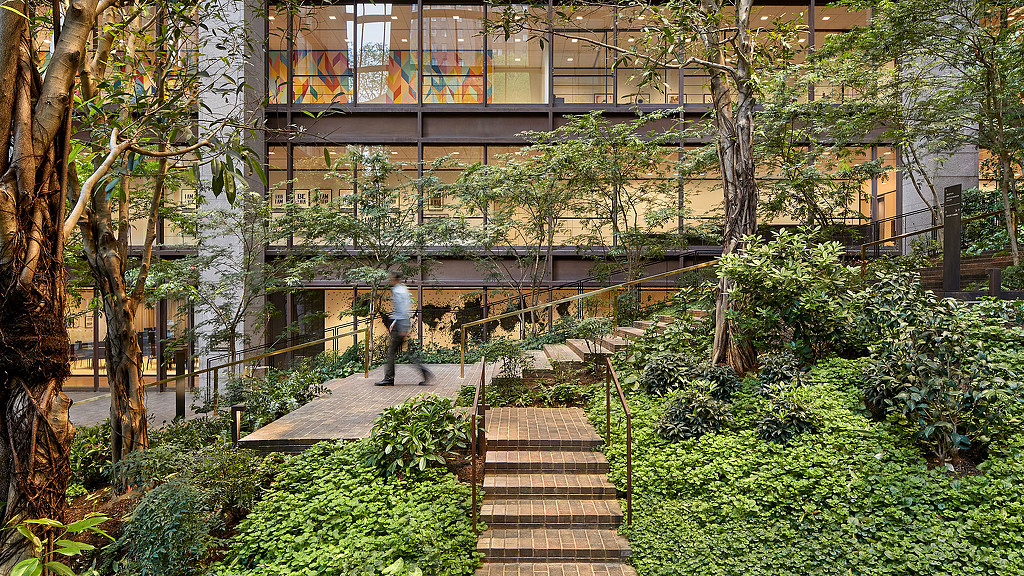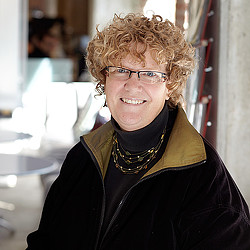Why Designing for Climate Action and Sustainability Is an Imperative
April 19, 2022 | By Kirsten Ritchie and Anthony Brower
Editor’s Note: Here, we sit down with Anthony Brower and Kirsten Ritchie, global leaders for Gensler’s new Climate Action & Sustainability practice, to discuss what’s next for climate action and sustainable design.
What are the biggest trends that you’re seeing impacting climate action and sustainable design in the next five years?
KR: What has been really interesting in the whole realm of resilience, sustainability, and climate action is the awareness of the role of the built environment — both from the operating carbon side, as well as the embodied carbon side. And if the real estate world can come together and say, “We can drive this to zero,” it will go a very long way to solving our global climate problem. With that whole community coming together — builders, developers, occupiers, design engineering partners, manufacturers —and saying, “We’re universally committed to making this change,” the difference that we can make is profound.
AB: On a global scale, it’s been very interesting to me to look beyond our traditional design and building focus to the larger social impacts of climate change and how that might relate to design in the long term.
What specific challenges are clients coming to you with right now, and how are you addressing them?
AB: One challenge we often run into with clients is aligning around a shared understanding. What does sustainability or climate impact mean to them and what role does it play in their industry?
Building codes are another challenge. Some have good intentions; like incorporating meaningful performance requirements, but at the same time, some of those nuanced regulations add in unintended restrictions that keep us from really realizing a lot of our clients’ sustainability goals.
KR: There have also been some great examples of where building codes have galvanized action. Look at Local Law 97 in New York, which is holding building operators or owners accountable for the carbon emissions of their buildings. Even smaller cities are banning natural gas in new buildings, and driving buildings to go all-electric.
Another challenge is learning the vocabulary. For years, people have been hearing about net zero energy. Well, the truth is, we always are going to need energy, but that energy doesn’t have to come with a carbon footprint. There’s a whole mind shift of recognizing that the energy we use can be carbon-free energy.
We’re also seeing a lot of our clients making climate declarations to procure 100% renewable energy, or they’re going to be carbon zero by 2030, 2040, or 2050. But that’s not always necessarily translating to real estate. So, one of our big opportunities is to help our clients bridge that gap so that we can transpose those differences into the built environment, and letting them celebrate their real estate holdings, and how that is factoring into the delivery of their commitments.
Helping clients get prepared is a big theme of Gensler’s climate action research. How can Gensler help our clients get prepared for climate disasters?
KR: We have short-term stressors of being resilient in the face of a shock. So, in the face of an earthquake, or a major flood event, wildfires, or a huge heat wave, what can we design to handle those shocks? And making sure the buildings are resilient, always being upgraded, and designed to current, or future codes.
But then there are the long-term stressors, such as sea level rise. So, if you’re building an environment that’s in a flood zone, account for it, and design from the get-go to not have any critical facilities that are below the 100-year flood plus some buffer.
And then there’s the whole idea of microgrids, distributed energy resources, or becoming an entity that can operate separately from the grid. I think we’re going to be seeing more systems that can thrive independently, but that are also interconnected.
Environmental, Social, and Corporate Governance (ESG) goals are top of mind for many clients. Why is this topic coming to the forefront now, and what is the value that design can bring?
AB: There’s this huge push for companies to have climate goals and determine ESG values that drive a company. And the “E” is a big piece of that. What are their environmental goals? A lot of companies are leveraging existing programs like LEED, Fitwel, or other third-party non-profit rating systems to measure their performance. But shifting to ask, what are the design impacts we can influence? Are there hidden metrics that can add value? Our team is digging these issues to uncover how different building types can benefit from thinking about ESG from a design perspective, and convert ESG tracking from a backwards-looking reporting tool of “what did we do,” to a forward-looking approach examining “how can we use this to design better?”
KR: We’ve really been focused on the “E” side, but with the climate action practice area, we also have opportunities to help influence on the social and governance side. For example, we’re working with the City of San Francisco to come up with code criteria for mothers’ rooms and all-gender restrooms. Those kinds of things clearly fit into improving the built environment from the social perspective, but we’re using partnerships on the governance side to make it happen.
What are some of the diverse services Gensler is offering with launch of new Climate Action & Sustainability practice?
AB: We’re focused on three big buckets: certification, strategy, and analytics. The first is more familiar built environment sustainability certification programs and the expertise that leans into those programs. We’re also pushing the envelope and looking at LEED Zero or ILFI Zero, or expanding geographically, for example, by focusing on BREEAM in Europe to better service our European-based clients.
KR: The second area of focus is strategy. How are we helping our clients with developing their own climate action plan? How do we bring consensus in a large organization around what their environmental and climate-related goals should be? Traditionally, there’s been a lot of strategy done relative to climate action for building owners, and much less so on global tenants. So, we’re working with our global account owners to rapidly prototype the operating carbon footprint of their leases across the world and helping them to prioritize where they need to focus.
The third category is analytics. That ties into the ESG conversation. How are we adding value through material lifecycle assessments so that we can make better decisions and measure our clients reduced carbon impact? How are we talking about energy consumption? We’re looking at embodied carbon analysis and really getting beyond the everyday analytics.
AB: When we talk about climate action, we’re really talking about doing the best we can on the highest performing buildings, but we’re also trying to ratchet in how our experts across the firm are making an impact or being an influencer to our clients and our own design teams.
KR: We have a strong, passionate design resilience community, and we’re raising all boats so that every single project, every single person networked throughout our firm is really focused on climate action.
For media inquiries, email .

